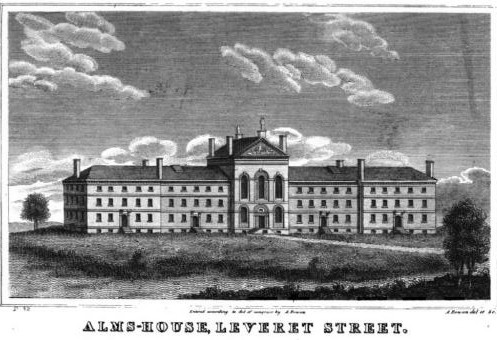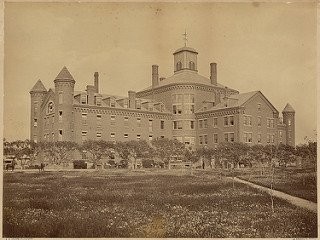The Boston Almshouse
Introduction
Text-to-speech Audio
Images
This map, created by Captain John Bonner, shows the location of the original Almshouse in historical Boston. Its proximity to wealthier areas contributed to its move in the 19th century. Image courtesy of the Colonial Society [6].
![This map, created by Captain John Bonner, shows the location of the original Almshouse in historical Boston. Its proximity to wealthier areas contributed to its move in the 19th century. Image courtesy of the Colonial Society [6].](https://storage.googleapis.com/clio-images/medium_68348.183613.jpg)
A view of the Almshouse, built by Charles Bulfinch from 1799-1801. It was demolished in 1825. Image courtesy of Wikimedia.

This is a view of the second Almshouse, located on Deer Island. Photo courtesy of Flickr.

Backstory and Context
Text-to-speech Audio
First and foremost, the almshouse was an important “general hospital within the Commonwealth of Massachusetts," that housed "the sick poor and the insane" [4]. It provided shelter, community, meals, and health services to its inhabitants, though to an insufficient extent. It’s meager efforts to address a visible need for social charity within the Commonwealth were based in the philanthropic conception of “alms,” or a gift given out of pity for the poor, but house overseers lacked an empirical, rehabilitative framework that targeted the needs of residents beyond providing necessities. The house attracted people from around the “province,” outside of Boston and even international people who moved to Boston for opportunity they never found. The same individuals would often be admitted more than once, for as little as a day to up to several years; admissions reflected a higher number than the residing people themselves because of this.
Following in Europe’s tradition of orphanages and almshouses, the first Boston Almshouse was built in the mid 17th century to become a safe haven for the poor and ill. After a devastating fire, the Boston Almshouse was rebuilt and relocated to Leverett St. overlooking the junction of the Charles River and Boston Harbor [5]. Between 1758 and 1800, the Boston Almshouse by the Overseers of the Poor had 7,200 admissions, mostly individual men, women, and children with some nuclear and single-parent families. The Almshouse was Boston’s cornerstone of poor relief and those who passed through its doors had been dislocated and impoverished by the industrial revolution or Revolutionary war [6]. It also housed newly arrived immigrants, former slaves, and the physically or mentally ill. Some sought entrance into the Almshouse while others were coerced by authorities who wanted to control the poor [7]. The Almshouse, though no longer in existence, is an important landmark in Boston’s urban history that affected thousands of impoverished people.
Stigma and a judgmental attitude toward the poor drove the movement of the Almshouse to Deer Island. Wealthy residents in gentrified Boston experienced discomfort and possessed the social capital necessary to engender an “out of sight, out of mind” relocation of the house. Further along the lines of social exclusion, the almshouse was also a source of moral weeding: Boston’s city magistrates employed legal mechanisms to organize almshouse inhabitants based on gender, social class, and moral behavior. For example, they relocated “bad,” morally abject individuals back to their hometowns rather than offer them a space in the almshouse. Likewise, the influx of African Americans only emerged following the emancipation of slaves. Despite these controversial, socially exclusive measures, the house was actually a woman-dominated, female-empowering space. Women in the almshouse occupied the same space and naturally formed close communities; although coercion and financial pressures may have motivated their stays in the house, women nonetheless “strategically managed their lives” and formed social bonds together.
Cite This Entry
Isabella, Lily, Sofia . "The Boston Almshouse ." Clio: Your Guide to History. November 13, 2018. Accessed March 31, 2025. https://theclio.com/entry/68348
Sources
1. Herndon, Ruth Wallis. "Poor Women and the Boston Almshouse in the Early Republic." Journal of the Early Republic 32, no. 3 (2012): 349-8.
2. “The Almshouse and Workhouse - Colonial Society of Massachusetts.” n.d. Accessed October 26, 2018. https://www.colonialsociety.org/node/3085.
3. Ibid.
4. Quincy, and Quincy, Josiah. Address of the Board of Trustees of the Massachusetts General Hospital to the Public. Boston: J. Belcher, 1814.
5. Herndon, Ruth Wallis, "Poor Women,” 349-8.
6. “The Almshouse and Workhouse.”
7. Ibid.
Additional sources:
Bulfinch, Bulfinch. Almshouse, Boston, Massachusetts, United States, 1799.
“Deer Island - Friends of the Boston Harbor Islands Established 1979.” n.d. Accessed October 26,
2018. http://www.fbhi.org/deer-island.html.
Hartnett, Kevin. "Beware the Boston Almshouse." The Boston Globe. May 20, 2013. Accessed October 25, 2018.

